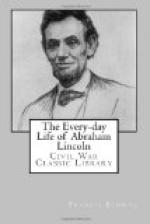Lincoln shared the same room with Mr. Speed during his early residence in Springfield, taking his meals with his companion at the house of Mr. William Butler, with whom he boarded for five years. His professional advancement at first was slow, and he had periods of great discouragement. An old settler of Illinois, named Page Eaton, says: “I knew Lincoln when he first came to Springfield. He was an awkward but hard-working young man. Everybody said he would never make a good lawyer because he was too honest. He came to my shop one day, after he had been here five or six months, and said he had a notion to quit studying law and learn carpentering. He thought there was more need of carpenters out here than lawyers.” Soon after Lincoln’s settlement in Springfield, he formed a law partnership with Major John T. Stuart, whom he had known for some years and who already had a good position at the bar. This partnership began, according to the statement of Major Stuart, on April 27, 1837. It continued just four years, when it was dissolved, and Lincoln and Judge Stephen T. Logan became partners. This latter partnership continued about two years, when, on September 20, 1843, the firm of Lincoln & Herndon was formed, and it continued to the time of Lincoln’s death.
When Lincoln began to practice law, it was the custom in Illinois to “ride the circuit,” a proceeding of which the older communities of the East know nothing. The State of Illinois, for instance, is divided into a number of districts, each composed of a number of counties, of which a single judge, appointed or elected as the case may be, for that purpose, makes the circuit, holding courts at each county seat. Railroads being scarce, the earlier circuit judges made their trips from county to county on horseback or in a gig; and the prominent lawyers living within the limits of the circuit made the tour of the circuit with the judge. It is said that when Lincoln first began to “ride the circuit” he was too poor to own a horse or vehicle, and was compelled to borrow from his friends. But in due time he became the proprietor of a horse, which he fed and groomed himself, and to which he was very much attached. On this animal he would set out from home, to be gone for weeks together, with no baggage but a pair of saddle-bags containing a change of linen, and an old cotton umbrella to shelter him from sun or rain. When he got a little more of this world’s goods he set up a one-horse buggy, a very sorry and shabby-looking affair which he generally used when the weather promised to be bad. The other lawyers were always glad to see him, and landlords hailed his coming with pleasure; but he was one of those gentle, uncomplaining men whom they would put off with indifferent accommodations. It was a significant remark of a lawyer who was thoroughly acquainted with his habits and disposition that “Lincoln was never seated next the landlord at a crowded table, and never got a chicken-liver or the best cut from




